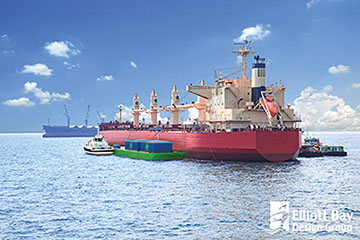Elliott Bay Design Group (EBDG) has designed a harbor power and charging barge that it says offers ports and harbors a cost-conscious and high-performing option to minimize emissions from large vessels both pier side and at anchor. The firm announced the design at the International Workboat Show in New Orleans, La.
Delivering 7 megawatts of continuous power generated by methanol, the floating mobile platform is capable of cold ironing even the most demanding vessels both at the pier and at anchor for up to two weeks before refueling.
In addition, it offers double duty as an “in-field” DC charging station for electric harbor tugs and other smaller service vessels. An independent ultra-low emission and nearly silent 1 megawatt system with 10 megawatt-hours of reserve capacity continuously replenishes its reserve to provide fast charging capacity on-demand directly in the operating field of the vessels it serves, eliminating the need to run to and from the dock and for costly and intrusive pier-side charging infrastructure.
The vessel is equipped with a Wärtsilä W32M Tier IV methanol generator for cold ironing and features e1 Marine’s M30 hydrogen reformer technology coupled with PowerCell’s PS-185 fuel cell system for fast charging. This combination of commercially available technologies offers exhaust emission reductions of more than 70 percent compared with conventional diesel at equivalent power, EBDG said. Zero full cycle emission is also achievable with an optional Wärtsilä carbon capture system and certified green methanol fuel.
All of this capability is integrated into a barge platform less than 225 feet in length, making it safe and convenient for use in the world’s busiest ports and tightest harbors, EBDG said. Double-hull protection of the methanol storage tanks, T1(b) Classification by Lloyd’s Register and Marpol 21.1.2 compliance, further optimize its safety and environmental benefit.




